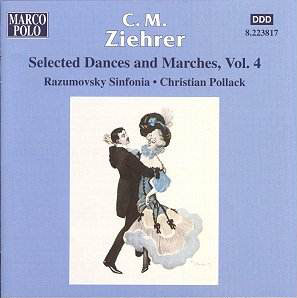Carl Michael Ziehrer was one of the greatest
rivals of the Viennese Strauss family. He was at three times in
his career a bandmaster and therefore it may not be surprising
that so many of his compositions have a certain brashness and
swagger as well as elegance. Ziehrer enjoyed a very successful
career composing operettas which found their way into most continental
European cities and some were performed on Broadway. These operettas
maintained the form of the so-called Golden Era, soon to be overtaken
by the more romantic style of the Silver Age started by his friend
Franz Lehár.
Ziehrerís waltzes, polkas, marches and mazurkas
are written in the very familiar Viennese style of Johann Strauss.
All are elegantly tuneful and a reminder of a bygone age of innocence
(?) and refinement.
The English titles given above hint at the composerís
sense of humour. The thundering bass drum of the Take Cover
March might suggest gunfire and the wickedly ironically titled
Without a Care Quick Polka would need, I think, a lot of
skill and care for dancers to keep up with its headlong pace.
And the bouncy Secret Loves Waltz, suggests a furtiveness
and, in its more explosive chords, illicit love discovered. The
delightful opening of Loverís Waltz might suggest a romantic
carriage ride through a Viennese park. Here magical use is made
of the xylophone and harp. Ziehrer introduced novelties into some
of his pieces: the most substantial work here, the opening Viennese
Girlsí Waltz, has a whistling sequence and Nature
Singersí Waltz begins with lots of birdsong. The waltzes have
such a wonderfully romantic lilt. One can easily imagine women
in gorgeous ball gowns with their moustachioed and probably resplendent
uniformed beaux swirling under giant candelabra in the ballrooms
of fin de siècle Vienna.
All these little gems are performed with great
charm and élan by the Razumovsky Orchestra a special Naxos/Marco
Polo recording orchestra comprising the best players of the Slovak
Philharmonic, Slovak Radio Symphony Orchestra (Bratislava), Slovak
Chamber Orchestra and the Opera Theatre Orchestra. An undemanding
treat.
Ian Lace

